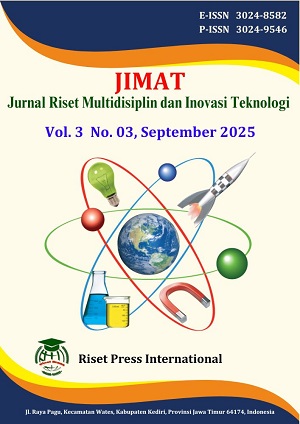Influence of ESG Ratings on Profitability Ratio in Company with ESG Values
DOI:
https://doi.org/10.59653/jimat.v3i03.1979Keywords:
ESG, Profitability, Rating, ROAAbstract
The research goal is analyze the influence of ESG ratings on financial ratios. Financial ratio studied is profitability, with ROA as an indicator, in companies listed with ESG values on the Indonesia Stock Exchange. This study seeks to address the issue of how companies maintain their financial resilience and stability. This is based on the phenomenon of GHG emissions from research by the European Department of Communications in 2024. Quantitative methods were used to examine 13 samples consisting of 5 companies in the energy sector and 8 companies in the infrastructure sector from 2019-2023. The sample size was selected using a purposive sampling method. Data analysis techniques used were descriptive statistical analysis and regression analysis, processed using IBM SPSS version 26. Meanwhile, data tabulation was performed using Microsoft Excel. The results of this study indicate that ESG ratings have a significant positive effect on the profitability financial ratio with ROA as an indicator. This is supported by the robustness test results using the regression method with the addition of control variables, proving the model's robustness. Based on these results, the implications of this study are that it can serve as a reference for companies implementing ESG to improve their ROA, and for investors when selecting companies to invest.
Downloads
References
Astuti, T., Magdalena, M., Mandagie, YR, & Irawan, T. (2024). A Relationship Assessment Between Environmental Practices, Corporate Values, and CSR in Sustainability Context. https://doi.org/10.21831/economia.v20i1.71341
Baratta, A., Cimino, A., Longo, F., Solina, V., & Verteramo, S. (2023). The Impact of ESG Practices in Industry with a Focus on Carbon Emissions: Insights and Future Perspectives. In Sustainability (Switzerland) (Vol. 15, Issue 8). MDPI. https://doi.org/10.3390/su15086685
Basuki, AT, & Prawoto, N. (2016). Analisis Regresi dalam Penelitian Ekonomi dan Bisnis (Dilengkapi Aplikasi SPSS & EVIEWS) (1st ed., Vol. 1). PT Rajagrafindo Persada.
Berg, F., Kölbel, J. F., & Rigobon, R. (2022). Aggregate Confusion: The Divergence of ESG Ratings*. Review of Finance, 26(6), 1315–1344. https://doi.org/10.1093/rof/rfac033
Clément, A., Robinot, É., & Trespeuch, L. (2025). The use of ESG scores in academic literature: a systematic literature review. Journal of Enterprising Communities: People and Places in the Global Economy, 19(1), 92–110. https://doi.org/10.1108/JEC-10-2022-0147
EBA. (2021). EBA Report on Management and Supervision of ESG Risks for Credit Institutions and Investment Firms EBA/Rep/2021/18 EBA Report on Management and Supervision of ESG Risks for Credit Institutions and Investment Firms 2.
European Commission, & Joint Research Centre, Crippa, M., Guizzardi, D., Pagani, F., Banja, M., Muntean, M., Schaaf, E., Monforti-Ferrario, F., Becker, WE, Quadrelli, R., Risquez Martin, A., Taghavi-Moharamli, P., Köykkä, J., Grassi, G., Rossi, S., Melo, J., Oom, D., Branco, A., San-Miguel, J., Manca, G., Pisoni, E., Vignati, E. and Pekar, F. (2024). JRC Science for Policy Report GHG Emissions of All World Countries 2024. Office of the European Union. https://data.europa.eu/doi/10.2760/4002897,JRC138862
Freeman, R. E. (1984). Stakeholder Theory: The State of the Art. https://scholarship.richmond.edu/management-faculty-publications
Guo, K., Bian, Y., Zhang, D., & Ji, Q. (2024). ESG performance and corporate external financing in China: The role of rating disagreement. Research in International Business and Finance, 69, 102236. https://doi.org/10.1016/j.ribaf.2024.102236
Kasmir. (2008). Analisis Laporan Keuangan (1st ed.). PT RajaGrafindo Persada.
Khalil, M. A., Khalil, S., & Sinliamthong, P. (2024). From ratings to resilience: The role and implications of environmental, social, and governance (ESG) performance in corporate solvency. Sustainable Futures, 8. https://doi.org/10.1016/j.sftr.2024.100304
Li, W., Hu, H., & Hong, Z. (2024). Green finance policy, ESG rating, and cost of debt-Evidence from China. International Review of Financial Analysis, 92, 103051. https://doi.org/10.1016/j.irfa.2023.103051
Leniwati, D., Handayani, NF, Prasetyo, A., Wicaksono, N., & Wahyuni, D. (2023). Corporate Social Responsibility Disclosure, Environmental Performance, and Corporate Profitability: Green Innovation as Intervening Variable. AFRE Accounting and Financial Review, 6 (3), 384–393. https://doi.org/10.26905/afr.v6i3.11362
Pratiwi, A., Nurulrahmatia, N., & Muniarty, P. (2020). Pengaruh Corporate Social Responsibility (CSR) Terhadap Profitabilitas pada Perusahaan Perbankan Yang Terdaftar di BEI. Owner, 4 (1), 95. https://doi.org/10.33395/owner.v4i1.201
Rizqi, MA, & Munari, M. (2023). Effect of ESG on Financial Performance. Owner, 7(3), 2537–2546. https://doi.org/10.33395/owner.v7i3.1600
Santoso, S. (2001). SPSS Mengolah Data Statistik secara Profesional versi 7.5. PT. Elex Media Komputindo.
Suchman, & Mark C. (1995). The Academy of Management Review. In Jul (Vol. 20).
Sugiyono. (2022). Metode Penelitian Kuantitatif. Alfabeta Bandung.
Shi, B., Li, N., Gao, Q., & Li, G. (2022). Market incentives, carbon quota allocation and carbon emission reduction: Evidence from China's carbon trading pilot policy. Journal of Environmental Management, 319. https://doi.org/10.1016/j.envman.2022.115650
The Global Impact. (2004). Who Cares Wins—Connecting Financial Markets to a Changing World.
Wang, L., & Yang, L. (2024). Corporate ESG performance and trade credit financing: Moderating effect of life cycle. Borsa Istanbul Review, 24(4), 818–827. https://doi.org/10.1016/j.bir.2024.04.012
Wulandari, S. (2020). Pengaruh Corporate Social Responsibility (CSR) Disclosure terhadap Profitabilitas Perusahaan. Jurnal Ekonomi Akuntansi Dan Manajemen, 19 (1), 1–14.
Yuwono, W., & Aurelia, D. (2021). The Effect of Profitability, Leverage, Institutional Ownership, Managerial Ownership, and Dividend Policy on Firm Value. Journal of Global Business and Management Review, 3 (1), 15. https://doi.org/10.37253/jgbmr.v3i1.4992
Downloads
Published
How to Cite
Issue
Section
Categories
License
Copyright (c) 2025 Syalia Masarrah, Diah Hari Suryaningrum

This work is licensed under a Creative Commons Attribution-ShareAlike 4.0 International License.
Authors who publish with this journal agree to the following terms:
- Authors retain copyright and grant the journal right of first publication with the work simultaneously licensed under a Creative Commons Attribution-ShareAlike that allows others to share the work with an acknowledgement of the work's authorship and initial publication in this journal.
- Authors are able to enter into separate, additional contractual arrangements for the non-exclusive distribution of the journal's published version of the work (e.g., post it to an institutional repository or publish it in a book), with an acknowledgement of its initial publication in this journal.
- Authors are permitted and encouraged to post their work online (e.g., in institutional repositories or on their website) prior to and during the submission process, as it can lead to productive exchanges, as well as earlier and greater citation of published work (See The Effect of Open Access).























